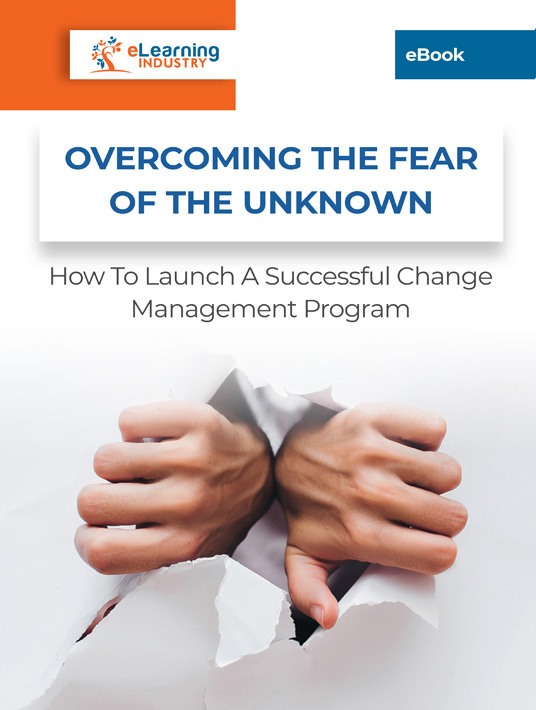Change Management Models For Your Online Training Program
Change management models give you the blueprints to get employees emotionally involved and prep them for upcoming obstacles. You don’t have to follow them to the letter, but they do offer some insight into mental processes and employee motivation. While some focus on widespread change, others involve smaller-scale transitions. How do you determine which model is right for your organization? Well, you can start by reading this all-in-one article, which features 7 unique approaches for your change management program. Then, get team eLearning feedback and evaluate your training objectives to pick the ideal online training strategy for your business processes. You might even decide to mix and match a few to customize your online training plan.

1. Lewin’s Change Management Model
Lewin’s model is all about the implementation of widespread change, for example, modifying the infrastructure of your organization or core business practices. It involves 3 key phases: unfreeze, change execution, and refreeze. Unfreeze focuses on awareness, informing employees about the upcoming change and mental preparation. Then, it’s time to actually make the change, but in incremental phases. You roll out new equipment, protocols, and processes to see what works and what needs to be improved. The last stage is to refreeze, which involves application across the board.
2. ADKAR Model
ADKAR (which is an acronym for the individual goals of the model) centers on employee emotions and behaviors impacted by the change. It was first introduced by the author Jeffery Hiatt. The 5 goals are awareness, desire, knowledge, ability, and reinforcement. Awareness focuses on employee buy-in and getting them to see the importance of the change. Desire pertains to emotional investment and support, while knowledge equips with the info they need to implement the change. Ability involves the application of that knowledge in the real world. Finally, you must ensure that the changes are carried out in the long-term by reinforcing change management online training.
3. The McKinsey 7-S Model
McKinsey, Peters, and Waterman founded the 7-S change management model. Instead of taking a step-by-step approach, this strategy proposes 7 key traits that organizations must have to successfully implement change. It also involves a continual reevaluation of your strategy to ensure that everything is in balance. The secret ingredients are:
- Shared values across the organization
- A staff that understands their roles and maintains a positive attitude
- Skills that align with company needs and objectives
- A style that consists of favorable behaviors in every department/job role
- A strategy that reflects your true purpose and how you’ll stay ahead of the competition
- Systems that clearly outline resource allocation, evaluation criteria, and employee incentives
- A structure that maps out the infrastructure and division of work duties
4. Kotter’s 8-Step Change Model
One of the more employee-centered change management models was introduced by John Kotter and is particularly useful for apprehensive staffers. He conducted surveys of over 100 organizations in the midst of change and defined 8 steps to transformational success:
- Ensure that employees are aware of the importance of the change and its urgency
- Form a solid collation within the organization
- Build a sound strategy and shared vision
- Win everyone over
- Break down barriers that hinder employee action
- Set and achieve short-term goals/milestones
- Maintain the momentum
- Implement change
5. Kubler-Ross Change Curve Model
This change management approach was originally intended for coping with loss or grief. It consists of 5 stages that employees go through during a significant change and addresses the emotional factors at play: denial, anger, bargaining, depression, acceptance. In many respects, change within your company is perceived as a loss for employees. They must let go of old habits, protocols, and leaders to make room for new business processes. Employees might try to deny that the change is taking place at first in order to avoid stress and fear. But they eventually accept the change and their new role within the organization.
6. Deming Cycle Model
Also known as the PDCA cycle (Plan, Do, Check, Act), the Deming Cycle consists of 4 stages that rely on the old "practice makes perfect" adage. It’s a more micro-approach, given that you must focus on individual processes, tasks, or protocols and fine-tune throughout the change. The first step is to plan and identify possible risks or areas for improvement. Then devise solutions to the problem. Next is to do, which centers on implementing small-scope changes to ensure the new approach is viable. The third phase is to check that the new process is, in fact, better than the current strategy/policy. Finally, you must act and implement the change within your organization or go back to the drawing board if it doesn’t succeed.
7. Bridges Transition Model
Bridges' change management model is less about strategy and more about the psychological impact on your employee training participants. It helps them transition through the change and the temporary chaos that comes with it. Which is why it’s usually paired with another model that does focus on strategic planning. The 3 emotional stages are:
- Ending, losing, and letting go
Employees say goodbye to the old ways and begin to experience feelings of loss, fear, and apprehension. Once they’ve dealt with these mental stressors, they’re able to let go of past processes. - The neutral zone
At this point, employees accept that change is coming but still need some reassurance to move on. - The new beginning
Employees are enthusiastic and excited about the change now that they’ve gone through the natural "grieving and acceptance" process. They begin to realize that the change is for the greater good and that it benefits their work practices and behaviors.
The best way to approach change management within your organization is to understand the emotional repercussions it has on your team members. Then, move onto the strategic side of things. You can’t simply introduce new leadership or business practices if staffers are resistant to change. Ease them into the process so that they bid adieu to old habits and welcome the new. They should never feel as though they’re being dragged into the new business venture or coerced into change.
Every organization must endure change from time to time, and this can be frightening. Download the eBook Overcoming The Fear Of The Unknown: How To Launch A Successful Change Management Program to discover how to launch a change management program that is destined to be a roaring success.

